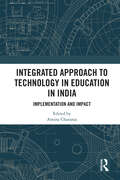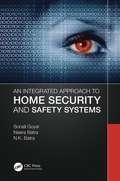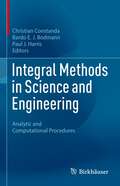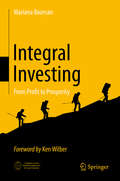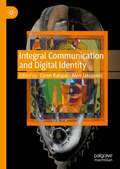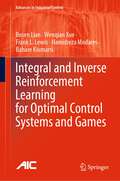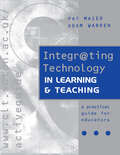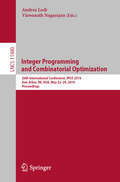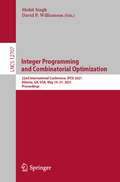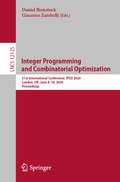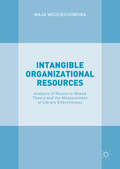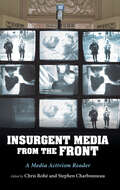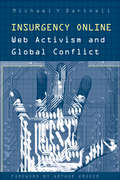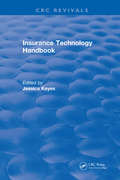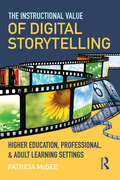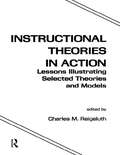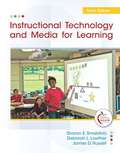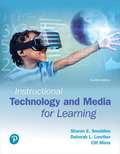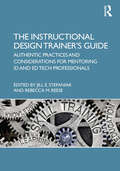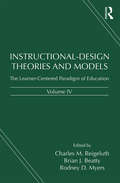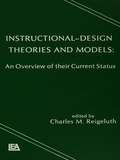- Table View
- List View
Integrated Approach to Technology in Education in India: Implementation and Impact
by Amina CharaniaThis book explores the evolution of Integrated approach to Technology in Education (ITE), an initiative of Tata Trusts in India, and the many innovative ways in which it has helped enrich the learning process and fostered new skills for young people, especially those living in challenging environments. The book offers an in-depth look into authentic, creative and project-based learning experiences that have been facilitated by using technology in education in different settings in India, with case studies about opportunities and challenges of implementing ITE in the tribal pockets of West Bengal and Maharashtra, madrasas in West Bengal, government schools in rural Assam and sites in Uttar Pradesh. It examines the viability and sustainability of using ITE and other digital methods to address the complex education needs of children and address the challenges in the professional development of teachers. It also highlights the creative use of inquiry, project-based collaborative learning and distance education technologies during the pandemic in government-run schools. This book will be of interest to teachers, students and researchers of education, education technology, ICT and education, digital education and information technology. It will also be useful for educators, policymakers, educational institutions, EdTech start-ups and NGOs in the education sector.
An Integrated Approach to Home Security and Safety Systems
by Sonali Goyal Neera BatraThis book provides an integrated solution for security and safety in the home, covering both assistance in health monitoring and safety from strangers/intruders who want to enter the home with harmful intentions. It defines a system whereby recognition of a person/stranger at the door is done using three modules: Face Recognition, Voice Recognition and Similarity Index. These three modules are taken together to provide a percentage likelihood that the individual is in the "known" or "unknown" category. The system can also continuously monitor the health parameters of a vulnerable person living alone at home and aid them in calling for help in an emergency. The authors have analyzed a number of existing biometric techniques to provide security for an individual living alone at home. These biometric techniques have been tested using MATLAB® image processing and signal processing toolboxes, and results have been calculated on the basis of recognition rate. A major contribution in providing security is a hybrid algorithm proposed by the author named PICA, which combines features of both PCA (Principle Component Analysis) and ICA (Independent Component Analysis) algorithms. This hybrid approach gives better performance recognition than either system alone. The second proposed hybrid algorithm for voice recognition is named as a MFRASTA algorithm by combining features of MFCC (Mel Frequency Cepstral Coefficient) and RASTA-PLP (RelAtive SpecTrA-Perceptual Linear Prediction) algorithm. After performing experiments, results are collected on the basis of recognition rate. The authors have also proposed a third technique named as a Similarity Index to provide trust-based security for an individual. This technique is text independent in which a person is recognized by pronunciation, frequency, tone, pitch, etc., irrespective of the content spoken by the person. By combining these three techniques, a high recognition rate is provided to the person at the door and high security to the individual living independently at home. In the final contribution, the authors have proposed a fingertip-based application for health monitoring by using the concept of sensors. This application is developed using iPhone 6’s camera. When a person puts their fingertip on a camera lens, with the help of brightness of the skin, the person’s heartbeat will be monitored. This is possible even with a low-quality camera. In case of any emergency, text messages will be sent to the family members of the individual living alone by using 3G Dongle and MATLAB tool. Results show that the proposed work outperforms all the existing techniques used in face recognition, voice recognition, and health monitoring alone.
Integral Methods in Science and Engineering: Analytic and Computational Procedures
by Christian Constanda Bardo E. J. Bodmann Paul J. HarrisThis volume contains a collection of articles on state-of-the-art developments in the construction of theoretical integral techniques and their application to specific problems in science and engineering. Chapters in this book are based on talks given at the Seventeenth International Conference on Integral Methods in Science and Engineering, held virtually in July 2022, and are written by internationally recognized researchers. This collection will be of interest to researchers in applied mathematics, physics, and mechanical, electrical, and petroleum engineering, as well as graduate students in these disciplines and other professionals for whom integration is an essential working tool.
Integral Investing: From Profit to Prosperity
by Mariana BozesanToday, early-stage investors and entrepreneurs find themselves in a dilemma in which they must choose between profit and impact; between traditional, for-profit-only models on the one hand, and multiple-bottom-line structures with a positive social or environmental impact on the other. To help them, and in response to a time in which climate change, exponentially growing technologies, and COVID-19 are calling into question humanity’s priorities, the author proposes a new investment paradigm, namely Integral Investing.Integral Investing incorporates and transcends the best practices of both traditional venture capital and impact investing. It provides a seamless integration and shows how technological progress need not be our rival, but can instead be our ally in ensuring the prosperous society we all want. Drawing on her own investments and stellar track record in Silicon Valley and Germany over the past 25 years, the author reveals the mechanism of Integral Investing. At the heart of it is a powerful, 360-degree de-risking tool called the Theta Model, which reveals how to make smart investment decisions based on the comprehensive integration of traditional due-diligence criteria, sustainability metrics, and assessments of the founders’ and team culture. But it doesn’t stop there. In turn, the book demonstrates how to use human-centered AI to scale and digitalize the investment process. The goal here is to accelerate the use of exponential tech, capital, and consciousness leadership to transition to a sustainable global society: a process the author refers to as the Investment Turnaround. The 21 principles of Integral Investing, which she defines using Ken Wilber’s Integral Theory, lead to her manifesto on how to implement the UN Sustainable Development Goals within Planetary Boundaries by 2050 through early-stage investing and entrepreneurship. Similar to the 15th century, when the Medicis inspired the Renaissance, today humanity is once again at a crucial turning point where pioneering financiers, investors, entrepreneurs, and other committed individuals have the opportunity to leave behind the legacy of a prosperous society. This handbook provides a source of inspiration, and shows how self-actualization, a positive mindset, and a consciousness that is backed by a world-centric desire can become the driving force for solving the global grand challenges.
Integral Communication and Digital Identity
by Ozren Rafajac Alen JakupovićThis book explains how taxonomy can be used to describe and connect social actors in an integral way. Integral communication refers to a specific way of open information exchange which uses all qualities and preferences of subjects in conversation and allows anonymous feedback exchange, which enhances trust, learning and development. The role of integral communication is to promote perceptiveness, collaboration, personal development, and organizational learning among all the actors involved.In this book, the authors propose a new original way of digital communication that uses tags and their metadata to describe qualities and preferences of a particular node in the network. Although most social networks, sharing platforms and e-government frameworks are already applying taxonomies and social tagging to define user identity, none of them is focused on tags exclusively, while within an integral communication framework they represent the basic element of user definition and networking. In addition, other social platforms rarely allow anonymous feedback exchange, and they are usually not focused on the personal development of their end-users. Aside from helping actors present their attributes and preferences, integral communication promotes teamwork, sustainability, trust, organisational learning, and personalized communication with AI machines.After reading this book, readers will learn how to harness the power of integral networking and understand why anonymous feedback is a critical element for learning and development.
Integral and Inverse Reinforcement Learning for Optimal Control Systems and Games (Advances in Industrial Control)
by Bosen Lian Wenqian Xue Frank L. Lewis Hamidreza Modares Bahare KiumarsiIntegral and Inverse Reinforcement Learning for Optimal Control Systems and Games develops its specific learning techniques, motivated by application to autonomous driving and microgrid systems, with breadth and depth: integral reinforcement learning (RL) achieves model-free control without system estimation compared with system identification methods and their inevitable estimation errors; novel inverse RL methods fill a gap that will help them to attract readers interested in finding data-driven model-free solutions for inverse optimization and optimal control, imitation learning and autonomous driving among other areas. Graduate students will find that this book offers a thorough introduction to integral and inverse RL for feedback control related to optimal regulation and tracking, disturbance rejection, and multiplayer and multiagent systems. For researchers, it provides a combination of theoretical analysis, rigorous algorithms, and a wide-ranging selection of examples. The book equips practitioners working in various domains – aircraft, robotics, power systems, and communication networks among them – with theoretical insights valuable in tackling the real-world challenges they face.
Integr@ting Technology in Learning and Teaching: A Practical Guide For Educators
by Maier, Pat Warren, Adam (both of the Interactive Learning Centre, Southampton University)This volume looks at the issues involved in integrating new technologies within the education process. It includes activities, case studies and notes for use by all teaching in higher education.
Integer Programming and Combinatorial Optimization: 20th International Conference, IPCO 2019, Ann Arbor, MI, USA, May 22-24, 2019, Proceedings (Lecture Notes in Computer Science #11480)
by Andrea Lodi Viswanath NagarajanThis book constitutes the refereed proceedings of the 20th International Conference on Integer Programming and Combinatorial Optimization, IPCO 2019, held in Ann Arbor, MI, USA, in May 2019. The 33 full versions of extended abstracts presented were carefully reviewed and selected from 114 submissions. The conference is a forum for researchers and practitioners working on various aspects of integer programming and combinatorial optimization. The aim is to present recent developments in theory, computation, and applications in these areas.
Integer Programming and Combinatorial Optimization: 22nd International Conference, IPCO 2021, Atlanta, GA, USA, May 19–21, 2021, Proceedings (Lecture Notes in Computer Science #12707)
by Mohit Singh David P. WilliamsonThis book constitutes the proceedings of the 22nd Conference on Integer Programming and Combinatorial Optimization, IPCO 2021, which took place during May 19-21, 2021. The conference was organized by Georgia Institute of Technology and planned to take place it Atlanta, GA, USA, but changed to an online format due to the COVID-19 pandemic. The 33 papers included in this book were carefully reviewed and selected from 90 submissions. IPCO is under the auspices of the MathematicalOptimization Society, and it is an important forum for presenting the latest results of theory and practice of the various aspects of discrete optimization.
Integer Programming and Combinatorial Optimization: 21st International Conference, IPCO 2020, London, UK, June 8–10, 2020, Proceedings (Lecture Notes in Computer Science #12125)
by Giacomo Zambelli Daniel BienstockThis book constitutes the refereed proceedings of the 21st International Conference on Integer Programming and Combinatorial Optimization, IPCO 2020, held in London, UK, in June 2020. The 33 full versions of extended abstracts presented were carefully reviewed and selected from 126 submissions. The conference is a forum for researchers and practitioners working on various aspects of integer programming and combinatorial optimization. The aim is to present recent developments in theory, computation, and applications in these areas.
Integer Linear Programming in Computational and Systems Biology: An Entry-Level Text and Course
by Dan GusfieldInteger linear programming (ILP) is a versatile modeling and optimization technique that is increasingly used in non-traditional ways in biology, with the potential to transform biological computation. However, few biologists know about it. This how-to and why-do text introduces ILP through the lens of computational and systems biology. It uses in-depth examples from genomics, phylogenetics, RNA, protein folding, network analysis, cancer, ecology, co-evolution, DNA sequencing, sequence analysis, pedigree and sibling inference, haplotyping, and more, to establish the power of ILP. This book aims to teach the logic of modeling and solving problems with ILP, and to teach the practical 'work flow' involved in using ILP in biology. Written for a wide audience, with no biological or computational prerequisites, this book is appropriate for entry-level and advanced courses aimed at biological and computational students, and as a source for specialists. Numerous exercises and accompanying software (in Python and Perl) demonstrate the concepts.
Intangible Organizational Resources
by Maja WojciechowskaThis book addressesthe challenges of organizing modern-day institutions, focusing on themanagement of intangible organizational resources of libraries through bothlibrary science and management theory. Highlighting new informationrequirements, knowledge transfer technologies and changing patterns of social behaviour,Intangible Organizational Resources exploreshow these changes are affecting the organization of information services suchas libraries, and discusses what they mean for the effectiveness and quality oftheir services. Making a unique contribution in an otherwise under-exploredfield, this is an essential text for those involved in the organization ofinformation services.
InsUrgent Media from the Front: A Media Activism Reader
by Chris Robé and Stephen CharbonneauIn the 1940s, it was 16 mm film. In the 1980s, it was handheld video cameras. Today, it is cell phones and social media. Activists have always found ways to use the media du jour for quick and widespread distribution.InsUrgent Media from the Front takes a look at activist media practices in the 21st century and sheds light on what it means to enact change using different media of the past and present. Chris Robé and Stephen Charbonneau's edited collection uses the term "insUrgent media" to highlight the ways grassroots media activists challenged and are challenging hegemonic norms like colonialism, patriarchy, imperialism, classism, and heteronormativity. Additionally, the term is used to convey the sense of urgency that defines media activism. Unlike slower traditional media, activist media has historically sacrificed aesthetics for immediacy. Consequently, this "run and gun" method of capturing content has shaped the way activist media looks throughout history.With chapters focused on indigenous resistance, community media, and the use of media as activism throughout US history, InsUrgent Media from the Front emphasizes the wide reach media activism has had over time. Visibility is not enough when it comes to media activism, and the contributors provide examples of how to refocus the field not only to be an activist but to study activism as well.
Insurgency Online
by Michael Y. DartnellIn Insurgency Online, Michael Dartnell focuses on a new form of conflict made possible by global communications. The Internet, Dartnell argues, is affecting extensive changes to the way politics are carried out, by inserting a range of non-state actors onto the global political stage. He demonstrates that Web activism raises issues about the organization of societies and the distribution of power and contends that the development of online activism has far-reaching social and political implications, with parallels to the influence of the invention of the printing press, the telegraph, and the radio.Dartnell concentrates on Web activists who use the Net as a media tool, distinguishing this use from information terrorism, which threatens or harasses through 'hacking' or electronic sabotage. Using the examples of the Revolutionary Association of the Women of Afghanistan (RAWA), which opposed the Taliban, the Peruvian Movimento Revolucionario Tupac Amaru (MRTA) and its campaign against the Fujimori government, and the Irish Republican Socialist Movement (IRSM), Dartnell evaluates the political implications and general character of Web activism among non-state actors. Insurgency Online shows that online activism is a ripe, new territory for non-governmental actors to raise awareness and develop support around the world.
Insurance Technology Handbook
by Jessica KeyesThis desk reference for IT professionals in the insurance industry provides information about the latest technologies to improve efficiency and prediction.Topics include:imagingmodelingmanagement systemscustomer systemsInternet commerceIssues affecting all financial service sectors, such as the year 2000 problemThe Insurance Technology Handbook is geared toward all levels of technology management and financial services management responsible for developing and implementing cutting-edge technology.
Insurance and Human Rights (AIDA Europe Research Series on Insurance Law and Regulation #5)
by Birgit Kuschke Margarida Lima RegoThis volume examines the impact of and interplay between human rights and insurance. National, supranational and international legal instruments regulating the taking-up and pursuit of the business of insurance and reinsurance, (re)insurance distribution and the insurance contract often refer to or impact on human or fundamental rights. Courts are often faced with the sometimes seemingly impossible task of reconciling insurance core principles, practices and mind-sets with the principles and values stemming from human rights protection. In some cases, such as that of discrimination in insurance, this discussion has been going on for decades. Some deal with hot topics which have more recently emerged in light of developments stemming from technologic innovations (‘InsurTech’). The first part of the book focuses on insurance and the right to equal treatment. Discrimination on the basis of factors such as gender or age is tackled, from the perspectives of the European Union, Canada and South Africa. The second part of the book highlights the very relevant role played by insurance in the upholding of the right to health, covering the United States of America, Africa and Brazil. The third part of the book explores InsurTech's manifold challenges upon the right to privacy, focusing on European Union. The fourth part tackles the threat posed by insurance on the right to life in general, but with a particular focus on the United Kingdom. Written by legal scholars and practitioners, the book offers international, comparative and regional or national perspectives, aiming to contribute to a more thorough and systematic understanding of the interactions between these two very different fields of law, providing the industry as well as the scientific community with insights from both sides of this seemingly difficult to transpose divide.
The Instructional Value of Digital Storytelling: Higher Education, Professional, and Adult Learning Settings
by Patricia McGeeAlthough storytelling has been recognized as an effective instructional strategy for some time, most educators are not informed about how to communicate a story that supports learning—particularly when using digital media. The Instructional Value of Digital Storytelling provides a broad overview of the concepts and traditions of storytelling and prepares professors, workplace trainers, and instructional designers to tell stories through 21st century media platforms, providing the skills critical to communication, lifelong learning, and professional success. Using clear and concise language, The Instructional Value of Digital Storytelling explains how and why storytelling can be used as a contemporary instructional method, particularly through social media, mobile technologies, and knowledge-based systems. Examples from different sectors and disciplines illustrate how and why effective digital stories are designed with learning theory in mind. Applications of storytelling in context are provided for diverse settings within higher education as well as both formal and informal adult learning contexts.
Instructional Theories in Action: Lessons Illustrating Selected Theories and Models
by Charles M. ReigeluthCompanion volume to the award-winning best seller Instructional Design Theories and Models, this book serves as a concrete introduction to instructional design for curriculum developers, teachers and teacher trainers, and students. Eight major theorists translate their works and theories into sets of instructional prescriptions; corresponding model lessons provide step-by-step illustrations of these theories. Instructional Theories in Action features:*overviews of the most important prescriptions and corresponding sample lesson plans written by the original theorists;*practical, concrete approaches to presenting the major strategies and principles;*model lessons focusing on the same objectives to facilitate comparisons of the theories;*numbered comments that identify which instructional prescription is being implemented at each point of the sample lessons;*chapter introductions, footnotes, and student study questions, and*clear identification and cross referencing of commonalities that are often masked by varying terminology.
Instructional Technology and Media for Learning (Tenth Edition)
by Sharon E. Smaldino Deborah L. Lowther James D. RussellWith its hallmark ASSURE technology integration model and classroom cases, this renowned text places you squarely in the classroom while providing a framework that teaches you to apply what you learn about computers, multimedia, Internet, distance learning, and audio/visual technologies to the 21st Century classroom instruction. Filled with examples drawn from authentic elementary and secondary education situations, this text paints a vivid picture of technology and media enhancing and supporting teaching and learning. The ASSURE cases are supported by video, guided reflection prompts, and lesson plans that demonstrate strong technology integration and lesson planning. In addition to preparing educators with best practices to incorporate technology and media to meet the needs of 21st Century learners, the book includes strong coverage of copyright concerns, free and inexpensive media resources, as well as learning theory and instructional models. The tenth edition updates reflect the accelerating trend toward digitizing information and school use of technologies, especially in the Web 2. 0 era. The tenth edition also addresses the interaction among the roles of teachers, technology coordinators, and school media specialists, all complementary and interdependent teams within the school. Associated online resources sold seperately Fall 2011 at www.myeducationkit.com.
Instructional Technology and Media for Learning
by Sharon Smaldino Deborah Lowther Clif Mims James Russell<p>Specific, realistic strategies for integrating technology and media into the PK-12 classroom. Using the ASSURE lesson plan model, Instructional Technology and Media for Learning, 12th Edition, demonstrates how to implement a complete range of technology and media formats that can be used to support and enhance teaching and learning. Written from the viewpoint of the teacher, the text highlights everyday teaching challenges and shows educators practical solutions for incorporating technology and media into their classroom. Examples are drawn from elementary and secondary education, covering a wide range of content areas. <p>The 12th Edition keeps readers up to date with recent innovations in technology and media, including mobile, Web 2.0, social media, copyright issues, coding as literacy, transdisciplinary learning, artificial intelligence, and augmented reality. Expanded and revised discussions help teachers consider appropriate technology that aligns with content standards while meeting the learning needs of all students.</p>
The Instructional Design Trainer’s Guide: Authentic Practices and Considerations for Mentoring ID and Ed Tech Professionals
by Jill E. Stefaniak Rebecca M. ReeseThe Instructional Design Trainer’s Guide provides foundational concepts and actionable strategies for training and mentoring instructional design and educational technology students to be effective across contexts. ID faculty are charged with bridging the gap between research and practice preparing graduate students for the real-world workforce. This book provides trainers and university programs with authentic learning experiences that better articulate the practices of and demands on design and technology professionals in the field. Through this enhanced perspective, learners will be better positioned to confidently embrace constraints, work among changing project expectations, interact with multiple stakeholders, and convey to employers the skills and competencies gleaned from their formal preparation.
The Instructional Design Trainer’s Guide: Authentic Practices and Considerations for Mentoring ID and Ed Tech Professionals
by Jill E. Stefaniak Rebecca M. ReeseThe Instructional Design Trainer’s Guide provides foundational concepts and actionable strategies for training and mentoring instructional design and educational technology students to be effective across contexts. ID faculty are charged with bridging the gap between research and practice preparing graduate students for the real-world workforce. This book provides trainers and university programs with authentic learning experiences that better articulate the practices of and demands on design and technology professionals in the field. Through this enhanced perspective, learners will be better positioned to confidently embrace constraints, work among changing project expectations, interact with multiple stakeholders, and convey to employers the skills and competencies gleaned from their formal preparation.
Instructional-Design Theories and Models, Volume IV: The Learner-Centered Paradigm of Education
by Charles M. Reigeluth, Brian J. Beatty, and Rodney D. MyersInstructional-Design Theories and Models, Volume IV provides a research-based description of the current state of instructional theory for the learner-centered paradigm of education, as well as a clear indication of how different theories and models interrelate. Significant changes have occurred in learning and instructional theory since the publication of Volume III, including advances in brain-based learning, learning sciences, information technologies, internet-based communication, a concern for customizing the student experience to maximize effectiveness, and scaling instructional environments to maximize efficiency. In order to complement the themes of Volume I (commonality and complementarity among theories of instruction), Volume II (diversity of theories) and Volume III (building a common knowledge base), the theme of Volume IV is shifting the paradigm of instruction from teacher-centered to learner-centered and integrating design theories of instruction, assessment, and curriculum. Chapters in Volume IV are collected into three primary sections: a comprehensive view of the learner-centered paradigm of education and training, elaborations on parts of that view for a variety of K-12 and higher education settings, and theories that address ways to move toward the learner-centered paradigm within the teacher-centered paradigm. Instructional-Design Theories and Models, Volume IV is an essential book for anyone interested in exploring more powerful ways of fostering human learning and development and thinking creatively about ways to best meet the needs of learners in all kinds of learning contexts.
Instructional-Design Theories and Models, Volume IV: The Learner-Centered Paradigm of Education
by Charles M. Reigeluth, Brian J. Beatty, and Rodney D. MyersInstructional-Design Theories and Models, Volume IV provides a research-based description of the current state of instructional theory for the learner-centered paradigm of education, as well as a clear indication of how different theories and models interrelate. Significant changes have occurred in learning and instructional theory since the publication of Volume III, including advances in brain-based learning, learning sciences, information technologies, internet-based communication, a concern for customizing the student experience to maximize effectiveness, and scaling instructional environments to maximize efficiency.In order to complement the themes of Volume I (commonality and complementarity among theories of instruction), Volume II (diversity of theories) and Volume III (building a common knowledge base), the theme of Volume IV is shifting the paradigm of instruction from teacher-centered to learner-centered and integrating design theories of instruction, assessment, and curriculum. Chapters in Volume IV are collected into three primary sections: a comprehensive view of the learner-centered paradigm of education and training, elaborations on parts of that view for a variety of K-12 and higher education settings, and theories that address ways to move toward the learner-centered paradigm within the teacher-centered paradigm. Instructional-Design Theories and Models, Volume IV is an essential book for anyone interested in exploring more powerful ways of fostering human learning and development and thinking creatively about ways to best meet the needs of learners in all kinds of learning contexts.
Instructional Design Theories and Models: An Overview of Their Current Status
by Charles M. ReigeluthInstructional Design Theories and Models is a thorough yet concise overview of eight of the most comprehensive and best-known attempts to integrate knowledge about effective and appealing instruction. Chapters were written by the original theorists to provide a more accurate and behind-the-scenes look at the theories' development. Instructional Des
